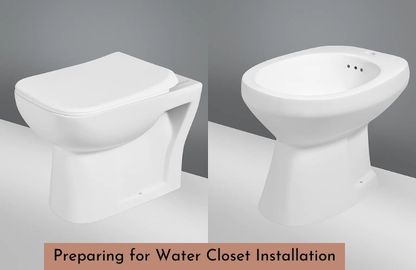
European water closets have become a hallmark of modern bathroom design, combining functionality with sophistication. For these high-quality fixtures to perform at their best, proper installation and maintenance are essential. In this guide, we’ll explore the best practices for both installing and maintaining your European water closet, ensuring its performance and extending its lifespan.
Essential Installation Guidelines for European Water Closets
Professional Installation for Precision and Reliability
To guarantee that your European water closet functions correctly from day one, professional installation is highly recommended. Skilled installers understand the nuances of fitting these advanced fixtures and can prevent issues like improper alignment or installation faults that DIY enthusiasts might miss. A properly installed unit ensures it works as intended, avoiding future repairs or inefficiencies.
Preparing the Bathroom Surface
Before installation, preparing the bathroom floor and wall is crucial. Ensure that the floor is level and the walls can support the weight of the fixture. Adequate preparation will prevent unwanted shifting, cracking, or leaks in the future. For wall-hung designs, ensure that the wall is reinforced with proper support for the mounting brackets.
Plumbing and Drainage Compatibility

To avoid any future issues, always verify that the plumbing connections align with the specifications of the European water closet. This includes checking the drainage system and water supply compatibility to ensure a seamless installation. Incorrect connections can lead to water leakage, inefficient flushing, or poor performance, so proper alignment is critical.
Secure Fixing and Waterproofing
Once your European water closet is aligned and connected, the next step is ensuring it’s securely mounted. Follow the manufacturer’s instructions for fixing it firmly to the floor or wall, using the appropriate mounting hardware. Additionally, seal all edges properly with high-quality waterproof caulking to prevent leaks that could lead to water damage in your bathroom.
Hidden Tank Systems
If you're opting for a concealed tank system, extra attention is required during installation. These systems are integrated into the wall, so it’s important that the installation is executed carefully to avoid future leaks or maintenance issues. The wall cavity must be large enough to house the system and allow for proper ventilation to ensure longevity.
Testimonials
the best sanitary ware I have ever seen
Key Maintenance Tips for European Water Closets
Establish a Regular Cleaning Routine
Keep your European water closet looking pristine by setting up a cleaning schedule. Regularly wipe down the surfaces to remove dirt, soap scum, or mineral deposits. Use mild, non-abrasive cleaners to preserve the toilet’s surface finish and prevent scratches or dulling over time.
Stay Away from Harsh Chemicals
Avoid the use of harsh chemicals or abrasive pads, which can damage the ceramic or porcelain surface of the European water closet. Natural, non-toxic cleaners are your best bet for maintaining the aesthetic and structural integrity of your toilet.
Regular Leak Inspections
Perform a quick inspection every few months to check for any potential water leaks. Look around the seal and flush mechanism for signs of wear or water seepage. Catching leaks early can prevent costly water damage or operational inefficiencies in the long run.
Monitor the Flush Mechanism
An often-overlooked component, the flush mechanism, should be periodically checked to ensure it works efficiently. If you notice irregular flushing behavior, such as inconsistent performance or water continuously running, address the issue promptly to prevent unnecessary water wastage.
Watch for Wear and Tear
Check for signs of wear and tear on the surface, including cracks, chips, or discoloration. It’s important to act fast when dealing with minor damages before they escalate. For example, small cracks in the porcelain can lead to water leakage and further damage to the fixture.
Inspect the Seat and Lid
The seat and lid are integral to the overall comfort and function of the European water closet. Inspect them for stability and ensure that the hinges remain tightly fixed. Tighten loose screws and replace any worn-out parts to ensure the fixture continues to function properly.
Client Speaks
Good company among Sanitaryware with best price
Maintain Seals and Gaskets
The seals and gaskets on your water closet play a critical role in preventing leaks. Over time, they can wear out or crack. Check them periodically to ensure they are intact and replace any damaged ones immediately to avoid water leakage.
Resolve Running Toilet Issues
A running toilet is not only annoying but also wasteful. If your European water closet experiences this issue, it's important to check for faults in the flush valve or the fill valve. A malfunctioning valve can lead to water wastage and should be repaired promptly.
Professional Check-ups
While DIY maintenance is important, it’s also wise to schedule periodic professional inspections for your European water closet. Experienced plumbers can identify potential problems early and offer preventive maintenance to extend the life of your fixture.
Follow Manufacturer Guidelines
Always adhere to the maintenance guidelines provided by the manufacturer. These instructions are specifically designed to ensure that your European water closet operates optimally. Neglecting manufacturer recommendations can void warranties and lead to unnecessary repairs.
Conclusion: Maximizing Performance and Durability
Installing and maintaining a European water closet doesn’t have to be daunting if you follow these best practices. Proper installation, regular cleaning, and proactive inspections are the key to ensuring your European water closet provides lasting performance. By investing time in the care of this vital bathroom fixture, you’ll enjoy not only a beautiful, high-functioning toilet but also a bathroom that remains in top condition for many years to come.
Make an Appoinment
Send us Message
Visit us at Address
Vagadiya Road, Thangadh - 363530,
Gujarat, India.
Gujarat, India.
© Copyright 2024, Orient Ceramics, All Rights Reserved.
Web Design & Development by Opal Infotech